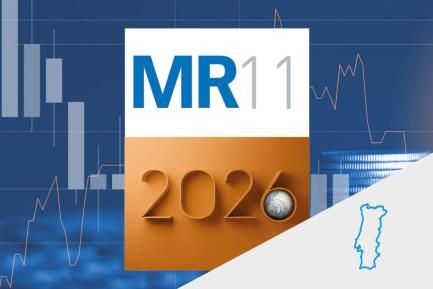
Inflation in Portugal: driven by electricity?
After several years in which it has been possible to combine low inflation with a highly dovish monetary policy, inflationary problems seemed to be dormant. However, with euro area inflation persistently above 2% in recent months, and even reaching 4.1% in October, alarm bells have been triggered. This opens the debate about when the ECB should reduce the level of complacency in its policy, bearing in mind that its ultimate objective is price stability.
Which components have causedinflation to rise?
Clearly, the energy component stands out as the major factor. In the case of Portugal, in the most recent months of 2021 for which we have data, the energy component accounts for more than 50% of the increase in inflation. Similar behaviour is observed in the euro area, where movements in energy prices are responsible for 2.1 pps of the 4.1% year-on-year change in the headline HICP in October. In September, the year-on-year change in the energy component in Portugal was 10.9%, while it reached an extraordinary 17.6% in the euro area (deteriorating in October to 23.5%).

The rise in energy prices is most clearly apparent in electricity. In the Iberian electricity market, the MIBEL, the average price between July and September was EUR 122.8/MWh, compared to the average price of EUR 39.6/MWh during 2020. This rally continued in October, reaching a peak of EUR 288.3/MWh on the 7th of the month. There are several factors behind this price rally, most notably the rise in the price of CO2 emission allowances and the price of natural gas (the fuel used in combined-cycle plants). Generating one MWh of electricity at a gas-fired power plant requires between 1.7 and 2.0 MWh of natural gas and emits 0.4 tonnes of CO2.

The rise in the price of gas in Europe has been influenced by the strong post-COVID economic revival, the prospect of the onset of winter with low gas reserves compared to previous years, as well as the uncertainty surrounding just how much of this commodity Russia will supply over the winter. Also, the lack of wind in many regions did not allow wind power to respond to the increased demand for electricity (the rate of electricity production from wind power is set by nature and not necessarily consumption), which intensified demand for gas as an alternative energy source. Finally, the way in which prices are formed in wholesale electricity markets has also played a part: the closing market price is that of the marginal power plant, that is, the price which is charged by the last power plant needed to meet demand, and thus the highest. Specifically, it is the gas-fired combined-cycle power plants that are setting this marginal price.
While these reasons for rising energy prices have affected the whole of the euro area, in Portugal the impact on overall inflation has been more moderate, since the rise in consumer electricity prices has been more contained. In September, the HICP for electricity rose by 2.3% in Portugal, while in the euro area it jumped by 10.9%.
What is the explanation for this Portuguese «electric miracle»?
There have been two main reasons: the way the regulated electricity market works and the payment of overruns to renewables. In Portugal, the price is regulated by the state and remains fixed throughout the year, although it can be revised mid-way through the year if prices in the MIBEL are not in line with the regulator’s forecasts. Although most Portuguese consumers are on liberalised market tarrifs, the fact that transit to the regulated market can be carried out without limitations, combined with the regulated market tariffs (BTN)1 which remain in force until 2025, reduces volatility and serves as a benchmark for the liberalised market price. On the other hand, around 40% of a consumer’s energy bill (excluding taxes) is related to the component of overruns from the PRE.2 This is an overrun associated with the purchase of renewable energy (which has a guaranteed tariff, usually higher than the selling prices on the wholesale market). The investments in renewables in recent decades were made with the guarantee that, for all the electricity produced during a given period, the developers would be paid at prices above market rates (FITs,3 which in the case of wind power are around EUR 90/MWh). Under «normal» circumstances, the market price in the MIBEL is below EUR 90/MWh, and consumers would pay the MIBEL price plus the differential for the FIT in the energy portion of their electricity bills. Now, however, the opposite is happening, and this has protected consumers from the rise in prices in the wholesale market.

What can we expect next year in terms of electricity prices?
Despite a 0.2% increase in the tariff due to be applied in 2022 for small consumers, the regulator indicates that this increase will be more than offset by the lower payment to renewables, which in 2022 is expected to provide a figure on the order of 1.7 billion euros in consumers’ favour.4 On the other hand, gas futures contracts, such as the Dutch TTF,5 indicate a price for April 2022 of EUR 45/MWh (the price for December 2021 is currently around EUR 78/MWh). With the current price of CO2 allowances, this would translate into an electricity price of EUR 114/MWh in the spring of 2022, still above the average MIBEL price in 2021 up to September (EUR 84.3/MWh). In addition to this, we must consider the tense relations between Algeria and Morocco that threaten the flow of supplies through the Maghreb-Europe pipeline, the main source of natural gas to the Iberian peninsula. It seems clear that there are opposing trends looming on the horizon: the component of overruns from renewables will follow a favourable trend, but the pressure on electricity prices on the wholesale market will still be felt, as has been the case in the last few months.



